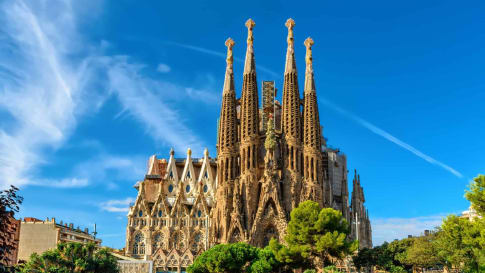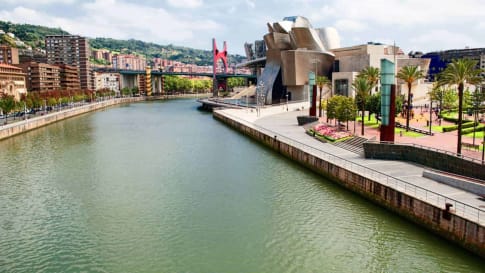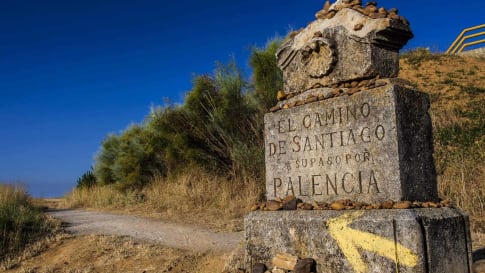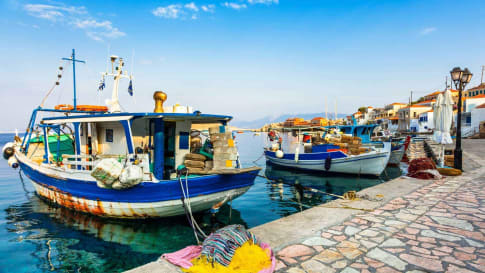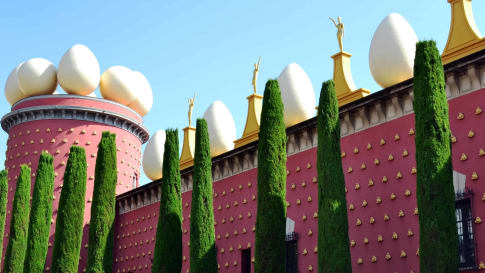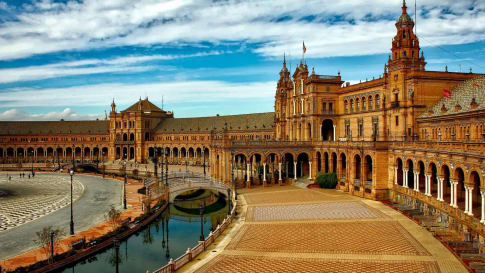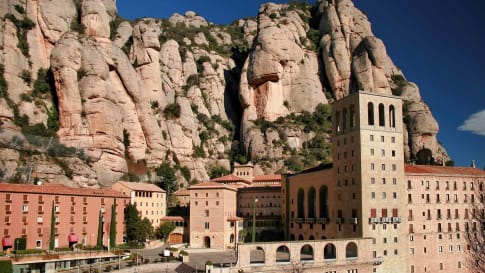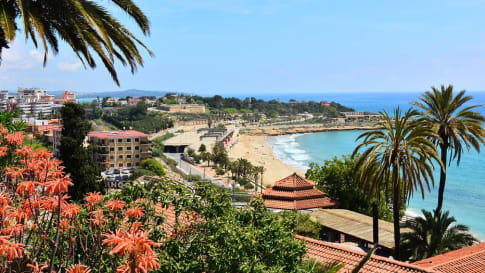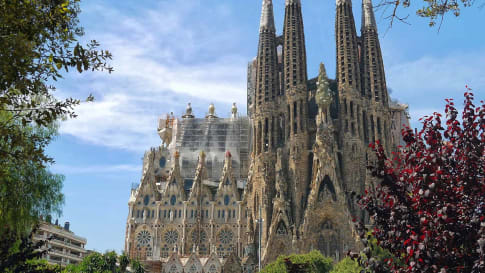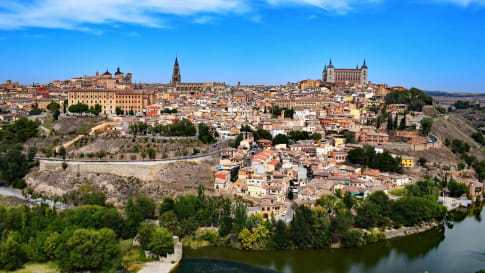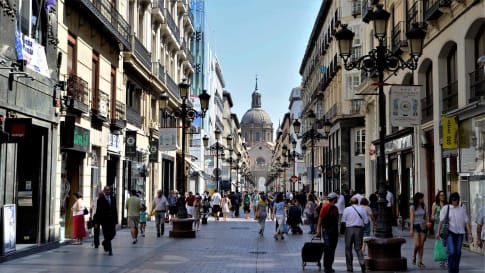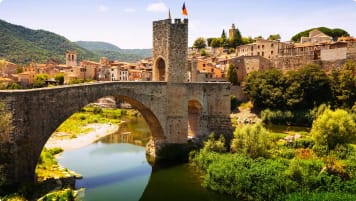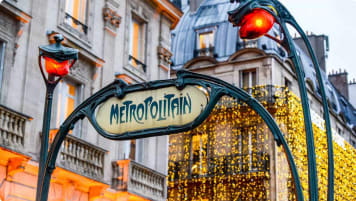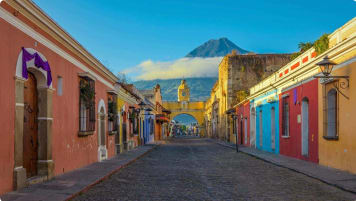Discover Spain
Join us on an escorted unforgettable 21-day small-group journey through Spain, perfect for both couples and solo travelers.
Immerse yourself in the heart and soul of Spain with local guides, offering authentic insights and unique experiences. From the historic streets of Madrid to the vibrant energy of Barcelona, you'll explore iconic landmarks, savor regional cuisine, and delve into the rich cultural heritage of this captivating country.
From €9,218EUR
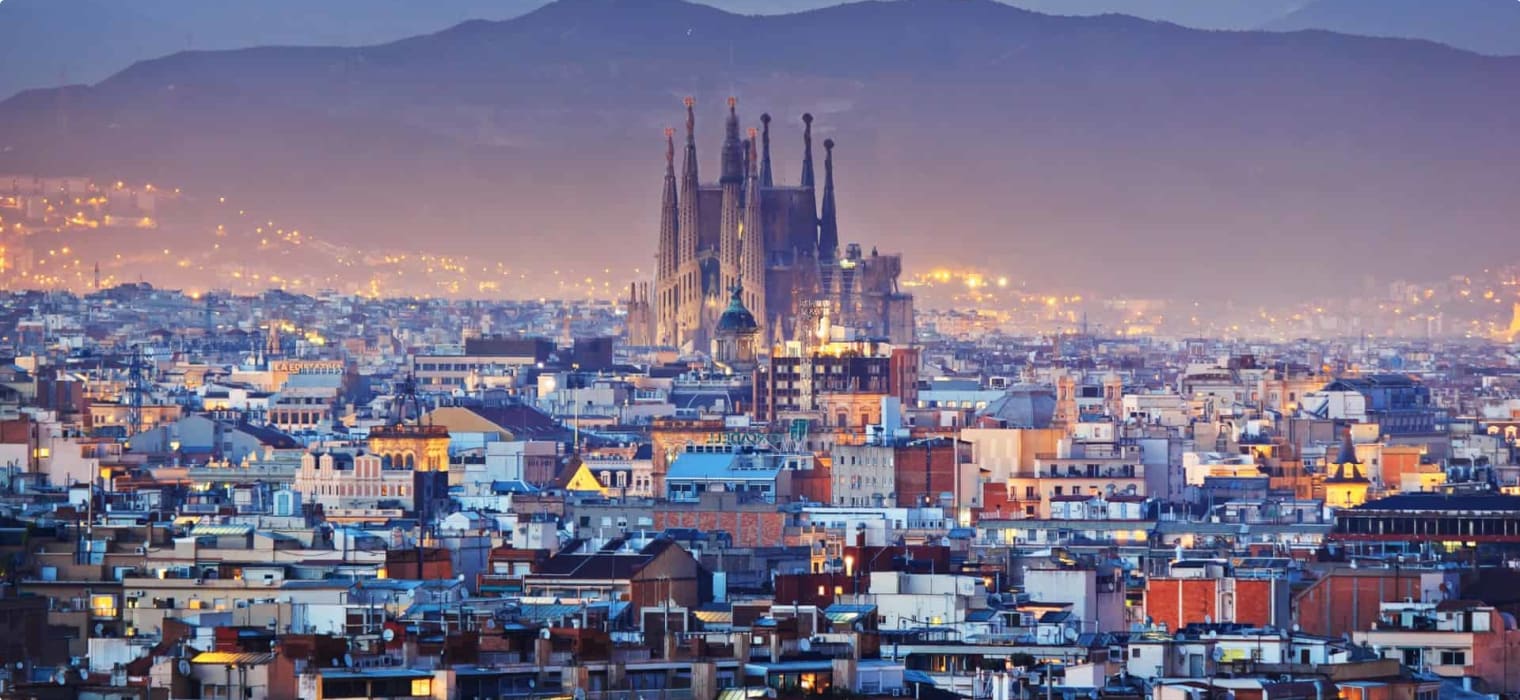
Highlights
- 1. Visit the Valley of the Fallen in San Lorenzo de El Escorial, a sombre and at times controversial monument commissioned by Francisco Franco and where the people who died in the Spanish Civil War were laid to rest.
- 2. Explore the city of Montserrat, and travel by cable car up to an abbey nestled in the mountain to visit the Black Madonna.
- 3. Experience the surrealist dreams of Salvador Dali in the Dali Theatre and Museum in Figueres.
- 4. View the Gaudi-designed monuments in Barcelona.

Departure Dates
| Departure Date | Price |
|---|---|
| 13 September 2025 Ends 03 October 2025 • 21 days €9,218 Twin €11,751 Single Available | Selected |
| 09 May 2026 Ends 29 May 2026 • 21 days €9,615 Twin €11,751 Single Available | |
| 12 September 2026 Ends 02 October 2026 • 21 days €9,615 Twin €11,751 Single Available | |
| 08 May 2027 Ends 28 May 2027 • 21 days €10,225 Twin €12,362 Single Available | |
| 11 September 2027 Ends 01 October 2027 • 21 days €10,225 Twin €12,362 Single Available |
Discover Spain: a small group tour for seniors
Join Odyssey Traveller on an immersive 21-day small-group tour of Spain designed for seniors. Experience the country’s grand sights and rich history as we journey from Madrid, Spain’s vibrant capital, to Barcelona, its dynamic cultural hub. Along the way, we explore charming towns often overlooked by mainstream tours, offering a unique and authentic glimpse into Spain’s diverse heritage.
This three-week journey, specially designed for senior travelers, offers a rich blend of sights and experiences. Our adventure begins in Madrid, a vibrant modern metropolis that has carefully preserved its historic neighborhoods and landmarks, making it the perfect gateway to Spain’s storied past. Just outside the city, we visit the Valley of the Fallen in San Lorenzo de El Escorial—a solemn and often debated monument commissioned by Francisco Franco, serving as the final resting place for those who perished in the Spanish Civil War.
We will visit the Roman Aqueduct of Segovia and the Roman Bridge of Cordoba, the Jewish Museum in Granada and Girona, and the Dali Theatre and Museum in Figueres. We will travel down to the foot of a striking multi-peaked mountain range to visit Montserrat, and travel by cable car to an abbey nestled in the mountain to visit the Black Madonna.
We will stop at Consuegra to see the windmills that Don Quixote de la Mancha mistook for giants in Miguel de Cervantes' famous novel, and at the mountaintop city of Ronda to view the bridges spanning a gorge that divides the new side of town (circa 15th century) from the old.
We also have a Spain and Portugal tour that explores the sights of the Iberian Peninsula, and an in-depth tour of Barcelona.
Articles by Odyssey Traveller to help prepare for this Spain Small Group Tour for Seniors
The following list of articles published by Odyssey Traveller for mature aged and senior travellers to maximise their knowledge and enjoyment of Spain when visiting;
- 15 of the best places in Spain to visit.
- Travel notes for Barcelona
- Ten of the best books published on Spain
- Ten of the Best art galleries in Europe to visit.
- Discovering Spain (and Portugal )
External articles to assist you on your visit to Spain
Other Odyssey Tours
Small group tour of Spain is only one of many Spain and Portugal tours offered by Odyssey Traveller. For more details, click the ‘Top 5’ or ‘Itinerary’ buttons above! If you’re keen to experience this tour, please call or send an email. Or, to book, simply fill in the form on the right hand side of this page.
Gallery
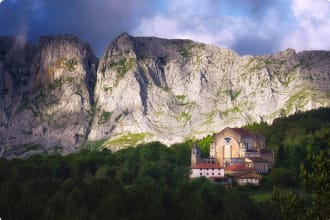
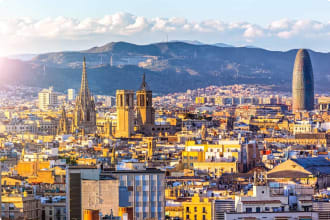

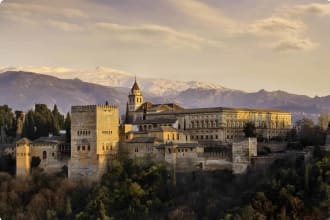
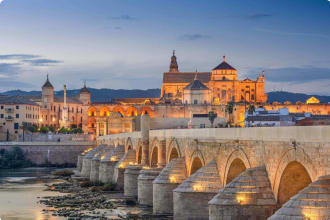

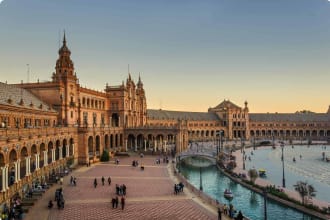

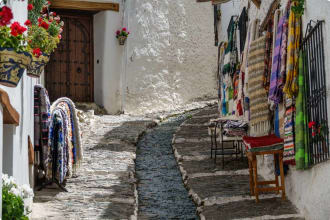
Itinerary
21 days
Day 1: Madrid
Accommodation: Hotel Sercotel Conde Duque or similar
Upon arrival in Madrid, we will make our own way to our hotel. We will come together in the evening for our welcome dinner at a local restaurant.
(D)
Day 2: Madrid
Accommodation: Hotel Sercotel Conde Duque or similar
Today we will have a full day as we take in the sights and sounds of Madrid. The capital of Spain, Madrid is a modern metropolis that has preserved its historic neighbourhoods and buildings, the perfect gateway to immerse ourselves in Spanish history. Among those we will visit today are Plaza Mayor, a major public square in the heart of Madrid; Mercado San Miguel, a covered marketplace established in 1916; and the Royal Palace, the official residence of the Spanish Royal Family in the city. (Please note that we will not be entering the palace.)
We will be exploring Museo del Prado, which holds artwork from artists such as Rembrandt, Rafael, and Hieronymous Bosch and Spanish painter Francisco Goya. We will also visit the Parque del Buen Retiro (“Park of the Pleasant Retreat”) which once belonged to the Spanish monarchy but is now a public park.
(B)
Day 3: Madrid
Accommodation: Hotel Sercotel Conde Duque or similar
We have no guided tours scheduled today so the day is free for us to enjoy! In the evening we will meet for a guided tapas tour where we will enjoy a traditional tapas dinner.
(B,D)
Day 4: Madrid - San Lorenzo de El Escorial - Segovia - Madrid
Accommodation: Hotel Sercotel Conde Duque or similar
Today we will head out of Madrid to the Valley of the Fallen in San Lorenzo de El Escorial, a sombre and at times controversial monument commissioned by former military leader Francisco Franco. The Valley, completed in 1959, is composed of an underground crypt and basilica–the Basílica de la Santa Cruz del Valle de los Caídos (Basilica of the Holy Cross of the Valley of the Fallen), where the bodies of the people who died in the Spanish Civil War were laid to rest (Franco’s remains are here as well)–topped with a 152.4-metre-high (500 feet) cross. Through the years it became a site of protest against the Spanish dictator and a venue for Francoists paying their respects, until 2007 when the Spanish government banned all political events from being held here.
On our way back to Madrid, we will stop at Segovia to view the Roman aqueduct, one of the most well-preserved Roman monuments, and explore the medieval Alcazar, including its artillery museum and tower.
(B)
Day 5: Madrid - Aranjuez - Toledo - Consuegra - Ciudad Real
Accommodation: NH Ciudad Real or similar
We will travel south of Madrid to Aranjuez to visit the Aranjuez Palace, which once served as a Spanish royal residence, begun during the reign of Philip II and completed during the reign of Charles III.
We will then explore Toledo, which before Madrid served as the imperial capital. We will enter the 13th century Toledo Cathedral, view the medieval Puente de San Martin linking the city to the west, built to complement the Puente de Alcantara in the east, which we will also visit; and visit the Puerta de Bisagra, the city gate of Toledo dating back to the 10th century. We will climb the road up to a famous viewpoint, the Mirador del Valle, which offers breathtaking panoramic views of the city. We will enjoy a late lunch in Toledo before we drive to Consuegra to see the windmills, made famous as “giants” in Miguel de Cervantes’s Don Quixote.
We will move on to Ciudad Real, where we will stay for the night.
(B,L)
Day 6: Ciudad Real - Cordoba - Seville
Accommodation: Hotel Becquer or similar
From Ciudad Real, we will travel to Cordoba and for a half-day tour of the main sights. We will view the Roman bridge of Cordoba, and visit the Mezquita-Catedral de Córdoba (Mosque–Cathedral of Córdoba), originally a mid-6th century Visigothic church turned into a mosque during Cordoba’s Islamic era.
During the Reconquista of the 12th century, the Christian army entered Cordoba and celebrated the Holy Mass inside the mosque, converting the city and the mosque-cathedral back to the Catholic faith.
We will transfer to Seville, where we will be spending the night. (B)
Day 7: Seville
Accommodation: Hotel Becquer or similar
Today we will be exploring Seville, founded as the Roman city Hispalis and now the capital of the Andalusia region. We will view the UNESCO-listed World Heritage Site of Seville, the monumental complex in the heart of the city consisting of the Seville Cathedral with the Giralda minaret, the Alcázar (fortress), and the Archivo de Indias. The Seville Cathedral is the largest Gothic cathedral in the world with its Giralda tower standing at 96 meters. Once an Almohad mosque, it was turned into a Catholic Cathedral following the Reconquista in 1248 and now holds the remains of Juan of Aragon, son of Ferdinand and Isabella, and Christopher Columbus. The Alcázar (fortress) of Seville, imbued with Moorish influences, is the oldest royal palace still in use in Europe. The Lonja, which became the Archivo de Indias (General Archive of the Indies), contains valuable documents illustrating the reach of the Spanish Empire in the Americas and in Asia. We will stroll through the grand Plaza de España and enter the bullring of the Real Maestranza de Caballería de Sevilla, site of the famous Seville bullfights.
(B)
Day 8: Seville
Accommodation: Hotel Becquer or similar
Today is a free day for us to further explore Seville, or to simply rest.
(B)
Day 9: Seville - Ronda - Granada
Accommodation: Hotel NH Collection Granada Victoria or similar
We will now journey to Granada, but en route we will stop at the mountaintop city of Ronda, which sits on top of the El Tajo gorge that separates Ronda’s 15th century new town from the old town that dates from Spain’s Islamic era. We will view Puente Nuevo and Puente Viejo, historic bridges that span the deep gorge.
(B)
Day 10: Granada
Accommodation: Hotel NH Collection Granada Victoria or similar
The city of Granada sits at the foot of the Sierra Nevada, and was once one of the most important cities of the Umayyad Caliphate in the Iberian Peninsula and, after the caliphate’s collapse, the centre of Jewish culture and scholarship. To learn more about Granada’s history, we will have a guided tour of the Alhambra Palace; a palace and a fortress and UNESCO world heritage listed. You will discover a unique Arab medieval citadel, probably the best preserved in the world, and also the highest tourist attraction in Spain. Accompanied by your local guide, we will visit the old Alcazaba, the Nazari Royal Palaces, the Palace of Carlos V or the Generalife, the summer residence of the Nazari monarchs. Admire panoramic city views and feel the atmosphere of the Moorish culture surrounded by the perfumes of the flowers and the murmuring of the water..
If time allows, we will visit the Sephardic Memory Centre in Granada in the Jewish Quarter; a small museum dedicated to the recreation of the culture, history, people and traditions of the Sephardic Jews of Jewish Granada.
In the evening we will be picked up from our hotel to share unique experience; We start with a charming stroll through the Albaicín neighborhood, followed by a visit to the Sacromonte, where you will attend the spectacular flamenco show and dinner at the Los Tarantos Caves.
(B,D)
Day 11: Granada - Murcia
Accommodation: Hotel Catalonia Conde Floridablanca or similar
Today we will travel from Granada to Murcia. In the afternoon we will visit the Royal Casino of Murcia, an iconic building that dates back to 1847. Its architecture showcases a blend of artistic styles from the late 19th and early 20th centuries in Spain. Recognized for its cultural significance, it was declared a National Historical Building in 1983.
(B)
Day 12: Murcia - Albacete - Cuenca
Accommodation: Hotel NH Ciudad de Cuenca or similar
From Murcia we will travel to Albacete in the historic La Mancha region, where we will have time to explore the city on our own. Albacete is more known as the transport hub of the region, but it also has two museums we can consider visiting: Museo Arqueológico (with a collection of Roman ivory) and Museo de la Cuchillería (museum of knives).
From Albacete we push on to Cuenca, where we will stay for the night.
(B)
Day 13: Cuenca
Accommodation: Hotel NH Ciudad de Cuenca or similar
Cuenca was originally the Roman town of Conca which fell under Muslim (8th century) and Castilian (12th century) influence in later centuries. In the 19th century, the city expanded and became divided into the upper, old city of Cuenca and the more modern city in the lowlands close to the railway from Madrid. The old city was listed as a World Heritage Site in 1996.
We will go on a guided half-day tour of the city and view the incredible Casas Colgantes (“Hanging Houses”) called as such as they appear suspended. We will also visit the Cuenca Cathedral and the Cathedral of the Immaculate Conception (also referred to as the “new” cathedral of Cuenca).
The remainder of the day is free.
(B)
Day 14: Cuenca - Albarracin - Teruel - Valencia
Accommodation: Hotel NH Valencia Center or similar
Today we will travel from Cuenca to Valencia, with a stop at Albarracin and Teruel. The Spanish themselves voted Albarracin, with its medieval houses and picturesque fortifications, as the most beautiful town in Spain in 2018–definitely the perfect place to stop and admire the views.
Teruel is known as the capital of Mudéjar architecture, a style that combines Islamic and Christian traditions.
We have the evening free upon arrival in Valencia.
(B)
Day 15: Valencia
Accommodation: Hotel NH Valencia Center or similar
Our guided Valencia tour begins at the Town Hall, which, along with the Central Market, which can be visited for free in the morning. We then continue to the Round Square, one of Valencia’s most distinctive attractions, known for its unique circular design.
Next, we visit the Cathedral and the Silk Exchange, two of the city’s most significant landmarks. The Silk Exchange, an iconic symbol of Valencia, is one of the most renowned examples of civil Gothic architecture in Europe and was designated a UNESCO World Heritage Site in December 1996. The Valencia Cathedral, offers a rich display of historical and artistic heritage. Its artwork, archives, and architecture reflect the cultural and religious vitality of the Valencian Christian community from the 4th century to the present day. Inside, visitors can admire an extensive collection of art, treasured relics, and remarkable architectural details.
Dinner will be held in a local restaurant tonight.
(B,D)
Day 16: Valencia - Tortosa
Accommodation: Hotel Parador de Tortosa or similar
Valencia is the third largest city in Spain after Madrid and Barcelona, with architecture ranging from the Roman era to the avant-garde, offering us plenty of places to see and explore. Before our drive to Tortosa today, we will visit The Ciudad de las Artes y las Ciencias (City of Arts and Sciences) – a cultural and architectural complex in Valencia. It is one of the most famous modern attractions in Spain, known for its futuristic architecture and stunning design by Santiago Calatrava and Félix Candela.
(B)
Day 17: Tortosa - Vilobi del Penedes - Montserrat - Barcelona
Accommodation: Hotel Abba Balmoral or similar
Today we drive to a vineyard – Codorniu Winery for a tour and wine tasting, before travelling to Montserrat. The city is located at the foot of the striking multi-peaked mountain range of the same name (Montserrat in Catalan means “saw mountain”). We will be visiting the Santa Maria de Montserrat on the mountain to view the Virgin of Montserrat, one of the Black Madonnas of Europe. To reach the Benedictine abbey and basilica, we will be taking a cable car ride that will also give us a panoramic view of the city.
From Montserrat, we transfer to Barcelona for our last 4 nights.
(B)
Day 18: Barcelona
Accommodation: Hotel Abba Balmoral or similar
Today will be spent exploring the vibrant city of Barcelona. We will be visiting the extraordinary Basílica i Temple Expiatori de la Sagrada Família designed by Catalan architect Antoni Gaudí and Barcelona’s triumphal arch Arc de Triomf. We will stroll through another Gaudi-designed space, the Parc Guell, and down tree-lined La Rambla. We will sample Barcelona’s gastronomic delights in the La Boqueria Market which dates back to the 13th century, and explore the historic Gothic Quarter.
(B)
Day 19: Barcelona - Girona - Figueres - Barcelona
Accommodation: Hotel Abba Balmoral or similar
Today we will venture out of Barcelona to the ancient Catalan city of Girona. We will discover Girona’s well-preserved Jewish quarter and dive into surrealism in Figueres, hometown of surrealist artist Salvador Dali. Here we will visit the Dali Theatre and Museum. Inaugurated in 1974, it is considered the last great work of Salvador Dali. You will be amazed by different collections including works of art of all kinds: paintings, drawings, sculptures, engravings, installations, holograms, stereoscopies, photographs…
We will enjoy a guided walking tour of Girona’s ancient city center followed by some free time to explore on
your own. You may wish to explore the Jewish Quarter of this picturesque city or seek out areas that served as a filming location for Game of Thrones.
(B)
Day 20: Barcelona
Accommodation: Hotel Abba Balmoral or similar
Today is a free day in Barcelona, which we may spend relaxing or exploring the corners of the city we have yet to see. In the evening we will sit down for our farewell dinner.
(B,D)
Day 21: Barcelona
The end of breakfast also marks the end of the tour and our services.
(B)
Includes / Excludes
What’s included in our Tour
- 20 nights of hotel accommodation.
- 20 breakfasts, 1 lunch and 5 dinners.
- Applicable entry fees and services of local guides.
- Touring by comfortable and modern coach.
- Field trips as indicated.
- Gratuities and necessary tips.
- Services of an Odyssey program leader.
- Detailed tour information booklet.
What’s not included in our Tour
- Return international airfare and departure taxes.
- Comprehensive travel insurance.
- Items of a personal nature such as telephone calls and laundry.
- Meals not specified in the itinerary.
Participants must be able to carry their own luggage, climb and descend stairs, be in good health, mobile and able to participate in 3-5 hours of physical activity per day, the equivalent of walking / hiking up to 8 kilometers per day on uneven ground.
Book now
Make it a private tour
Easing your journey
Crossing international borders with restrictions
The list of requirements to travel internationally has changed and will continue to change for several years. Odyssey is here to assist you in managing your way through these requirements:
For more information see our Crossing international borders with restrictions page.
Book With Confidence
If less than 30 days before your tour starts you are unable to travel as a result of Government travel restrictions, Odyssey Traveller will assist you with a date change, provide you with a credit or process a refund for your booking less any non-recoverable costs.
See Terms and conditions for details.
Peace of Mind Travel
The safety of our travellers, tour leader, local guide and support staff has always been our top priority and with the new guidelines for public health and safety for keeping safe for destinations around the world, we’ve developed our plan to give you peace of mind when travelling with us.
See Peace of Mind Travel for details.

